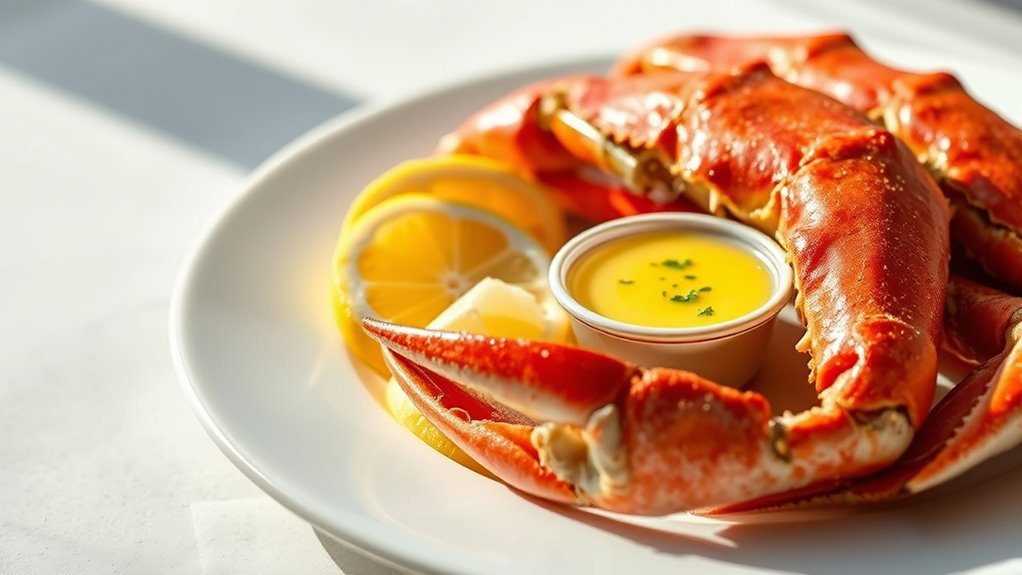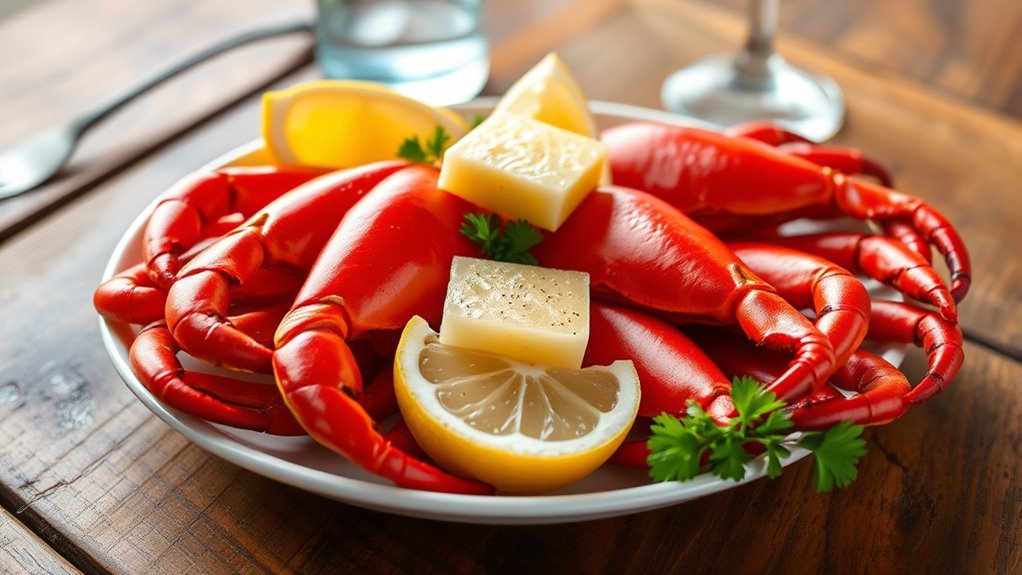Yes, crab legs are keto-friendly! With less than 1 gram of carbs per serving, they’re an ideal choice for your low-carb diet. They provide around 20 grams of protein, are low in calories and fat, and are rich in essential nutrients like vitamin B12 and selenium. Plus, they can easily be incorporated into delicious meals. If you’re curious about how to prepare them or want recipe ideas, there’s plenty more to discover!
Nutritional Profile of Crab Legs

When you consider the nutritional profile of crab legs, you’ll find they’re quite impressive. A typical serving of crab legs contains about 20 grams of protein, making them a fantastic source of lean protein. Regarding fat, they’re low, with only around 1.5 grams per serving, primarily consisting of healthy fats. The nutrient breakdown reveals essential vitamins and minerals, including vitamin B12, selenium, and zinc, which support various bodily functions. Crab legs are also low in calories—approximately 90 calories per serving—making them a great option for those seeking to maintain or lose weight. With their rich nutrient content and minimal carbs, crab legs can support your dietary freedom while providing essential nutrients without excess.
Carb Content in Crab Legs

When it comes to crab legs, you’ll find that their carb content is quite low, making them a suitable choice for a keto diet. Compared to other seafood options, crab legs typically contain fewer carbohydrates, allowing you to enjoy them without straying from your dietary goals. Understanding proper serving sizes and portions can help you maximize their nutritional benefits while keeping your carb intake in check.
Nutritional Profile Overview
Although you might be wondering about the carb content in crab legs, it’s essential to note that they are primarily composed of protein and healthy fats. These delicious seafood offerings are low in carbohydrates, typically containing less than 1 gram of carbs per serving. This makes crab legs an excellent choice for those following a keto diet.
In addition to their minimal carb content, crab legs provide significant nutritional benefits, including essential vitamins and minerals like vitamin B12, zinc, and selenium. These nutrients support various bodily functions, from immune health to energy production. Enjoying crab legs not only satisfies your taste buds but also aligns with your nutritional goals, granting you the freedom to indulge without compromising your diet.
Comparisons With Other Seafood
Crab legs stand out not just for their delicious flavor but also for their impressive nutritional profile, especially when compared to other seafood options. When you look at crab leg comparisons, you’ll notice that they typically have lower carbohydrate content than many other seafood alternatives. For instance, shrimp and lobster can be higher in carbs, depending on preparation methods. Crab legs usually contain about 1 gram of carbs per serving, making them a fantastic choice for those following a keto diet. Fish like salmon and tuna are also low in carbs, but crab legs offer a unique taste and texture that sets them apart. So, if you’re seeking a satisfying seafood option, crab legs are an excellent choice.
Serving Sizes and Portions
A typical serving of crab legs, around 3 to 4 ounces, contains approximately 1 gram of carbohydrates, making them a great option for anyone on a keto diet. Understanding serving sizes and practicing portion control can help you enjoy this seafood delicacy while keeping your carb intake in check.
| Serving Size | Carb Content |
|---|---|
| 3 ounces | 1 gram |
| 4 ounces | 1 gram |
| 6 ounces | 2 grams |
When you’re planning your meals, consider these portions. This way, you can indulge in crab legs without straying from your keto goals. Enjoy the freedom of savoring this delicious seafood while maintaining your low-carb lifestyle!
Health Benefits of Eating Crab Legs

Eating crab legs can be a great addition to your diet, as they’re a nutrient-dense source of protein and low in carbohydrates. Not only do they provide essential amino acids, but they’re also rich in omega-3 fatty acids, which are beneficial for heart health. Incorporating crab legs into your meals can support both your nutritional goals and overall well-being.
Nutrient-Dense Protein Source
When it comes to nutrient-dense protein sources, crab legs stand out for their impressive health benefits. They’re packed with high-quality protein, which is essential for muscle repair and growth. This protein aids in nutrient absorption, ensuring your body effectively utilizes vitamins and minerals. Additionally, crab legs are low in calories, making them a smart option for those watching their intake while still wanting to enjoy flavorful meals. They also contain essential minerals like zinc and selenium, which support immune function and overall health. Including crab legs in your diet can enhance protein quality, contributing to a balanced and nutritious lifestyle. So, if you’re seeking a satisfying, healthy protein source, crab legs are definitely worth considering.
Low in Carbohydrates
Crab legs are a fantastic choice for anyone looking to maintain a low-carbohydrate diet. They’re not just delicious; they also offer several low carb benefits that align perfectly with a keto lifestyle. Here are three key reasons to include crab legs in your meals:
- Minimal Carbs: Crab legs contain very few carbohydrates, making them an excellent option for keto friendly seafood.
- High in Protein: They’re packed with protein, which can help keep you full and satisfied without the carbs.
- Nutrient-Rich: Crab legs are loaded with essential vitamins and minerals, contributing to overall health while sticking to your dietary goals.
Rich in Omega-3s
Omega-3 fatty acids are essential for maintaining heart health, and crab legs are an excellent source of these beneficial fats. Including crab legs in your diet can provide numerous omega 3 benefits, such as reducing inflammation and lowering the risk of heart disease. Plus, they’re a delicious addition to your seafood sources.
| Omega-3 Benefits | Seafood Sources |
|---|---|
| Reduces heart disease risk | Crab legs |
| Supports brain health | Salmon |
| Aids in reducing inflammation | Mackerel |
How to Prepare Crab Legs for Keto
Preparing crab legs for a keto diet is both simple and rewarding, as they’re low in carbs and high in protein. Here’s how to do it using steaming techniques and a flavorful garlic butter:
- Clean the Crab Legs: Rinse them under cold water to remove any debris.
- Steam: Fill a large pot with water, bring it to a boil, then place a steaming basket with crab legs inside. Cover and steam for 5-7 minutes until heated through.
- Serve with Garlic Butter: Melt butter and mix in minced garlic for a delicious dipping sauce.
Enjoy your crab legs guilt-free, knowing they fit perfectly into your keto lifestyle! This method guarantees you retain their natural flavor while keeping your meal healthy.
Delicious Keto Crab Leg Recipes
While enjoying a keto diet, you don’t have to sacrifice flavor or variety, especially when it comes to seafood like crab legs. One delicious option is garlic butter crab legs, where you simply melt butter, mix in garlic and herbs, then pour it over steamed crab legs. For a revitalizing twist, try crab leg salad with avocado and a squeeze of lemon, providing healthy fats and vibrant flavors. Don’t forget about keto-friendly dips! A creamy avocado dip or a zesty ranch dressing pairs perfectly with your crab legs, enhancing the meal. These crab leg recipes not only satisfy your cravings but also keep you within your carb limits, making them a fantastic choice for your keto lifestyle. Enjoy!
Tips for Incorporating Crab Legs Into Your Meal Plan
Incorporating crab legs into your meal plan can be a delightful way to add variety and nutrition to your diet. Here are some tips to help you enjoy them while staying on track:
- Crab Leg Dips: Create a creamy crab leg dip using keto-friendly ingredients like cream cheese and herbs. It makes for a tasty appetizer.
- Keto Crab Salads: Toss crab meat with greens, avocado, and a tangy dressing for a rejuvenating salad. It’s low in carbs and rich in healthy fats.
- Meal Prep: Cook crab legs in bulk and store them in the fridge. You can easily add them to any meal throughout the week for a quick protein boost.
With these ideas, you’ll find it easy to include crab legs in your keto journey!
Other Seafood Options for a Keto Diet
Seafood is a fantastic choice for those following a keto diet, offering a variety of options that are low in carbs and high in protein. Besides crab legs, consider these sustainable seafood options that fit perfectly into your meal plan:
| Seafood Type | Carbs (per 100g) | Protein (per 100g) |
|---|---|---|
| Salmon | 0 | 25 |
| Shrimp | 1 | 24 |
| Mussels | 7 | 24 |
| Oysters | 4 | 9 |
These shellfish varieties not only provide essential nutrients but also promote health benefits like heart health. Experimenting with different seafood can keep your meals exciting while staying true to your keto lifestyle!
Frequently Asked Questions
Can I Eat Crab Legs Daily on a Keto Diet?
You can enjoy crab legs daily on a keto diet if you’re mindful of balance and moderation. Their nutritional benefits, like high protein and low carbs, support your dietary goals. However, it’s crucial to take into account your overall daily servings and guarantee you’re not missing out on other important nutrients. By incorporating a variety of foods, you’ll achieve freedom in your eating while still reaping the rewards of a low-carb lifestyle. Enjoy those crab legs!
Are There Any Allergies Associated With Crab Legs?
Yes, there are allergies associated with crab legs. Crab allergies are relatively common among seafood sensitivities, and they can trigger reactions ranging from mild to severe. If you’re unsure about your tolerance, it’s best to consult with a healthcare professional before indulging. Symptoms may include hives, difficulty breathing, or gastrointestinal issues. Being aware of potential allergies allows you to enjoy your meals while prioritizing your health and well-being. Stay informed and safe!
How Do Crab Legs Compare to Other Seafood in Protein Content?
When you compare crab legs to other seafood, you’ll find they’re high in protein and boast several nutritional benefits. A 3-ounce serving typically contains around 20 grams of protein, similar to shrimp and lobster. However, crab legs are lower in calories and fat than many alternatives, making them a lean choice. If you’re exploring seafood alternatives, crab legs offer a delicious option packed with nutrients while keeping your diet balanced and satisfying.
What’S the Best Dipping Sauce for Keto Crab Legs?
When it comes to the best dipping sauce for crab legs, you can’t go wrong with garlic butter. It enhances the rich flavor of the meat while keeping it keto-friendly. Another excellent choice is a lemon herb sauce, which adds a revitalizing zest that complements the sweetness of the crab. Both options are low in carbs, allowing you to enjoy your meal without worry. Experimenting with these sauces can elevate your dining experience!
Are Frozen Crab Legs as Nutritious as Fresh Ones?
When it comes to frozen versus fresh crab legs, think of it like a race between two champions. Frozen crab legs can maintain much of their nutrition, often being flash-frozen right after catch, locking in freshness. However, fresh crab legs may offer additional benefits, like superior taste and texture. Don’t underestimate frozen nutrition; it’s still a great option. Ultimately, your choice depends on your preference and availability, ensuring you enjoy that delicious seafood experience.


